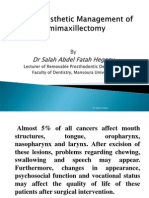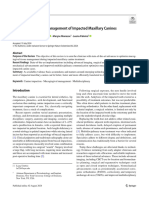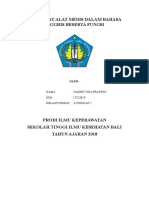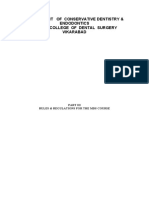0 ratings0% found this document useful (0 votes)
12 viewsMinimally Invasive Surgery in Implant Dentistry
Minimally Invasive Surgery in Implant Dentistry
Uploaded by
Adriana CoronadoCopyright:
© All Rights Reserved
Available Formats
Download as PDF, TXT or read online from Scribd
Minimally Invasive Surgery in Implant Dentistry
Minimally Invasive Surgery in Implant Dentistry
Uploaded by
Adriana Coronado0 ratings0% found this document useful (0 votes)
12 views1 pageOriginal Title
Minimally_invasive_surgery_in_implant_dentistry
Copyright
© © All Rights Reserved
Available Formats
PDF, TXT or read online from Scribd
Share this document
Did you find this document useful?
Is this content inappropriate?
Copyright:
© All Rights Reserved
Available Formats
Download as PDF, TXT or read online from Scribd
Download as pdf or txt
0 ratings0% found this document useful (0 votes)
12 views1 pageMinimally Invasive Surgery in Implant Dentistry
Minimally Invasive Surgery in Implant Dentistry
Uploaded by
Adriana CoronadoCopyright:
© All Rights Reserved
Available Formats
Download as PDF, TXT or read online from Scribd
Download as pdf or txt
You are on page 1of 1
https://doi.org/10.5125/jkaoms.2020.46.3.
161
EDITORIAL pISSN 2234-7550 · eISSN 2234-5930
Minimally invasive surgery in implant dentistry
Young-Kyun Kim, DDS, PhD
Editor-in-Chief of JKAOMS
Department of Oral and Maxillofacial Surgery, Section of Dentistry, Seoul National University Bundang Hospital, Seongnam, Korea
Oral and maxillofacial surgeons have been performing tures.
surgery and related studies in the implant dentistry field for The ideal treatment plan for implant dentistry is not nec-
a long time and have made significant contributions to the essarily good for the patient. Surgical treatment plans to
development of current implant therapy. In the past, implants improve this in the case of insufficient bone and poor bone
were installed after improving patient bone readiness through quality must be established first. However, it is necessary to
invasive surgical techniques in areas with bone deficiency or decide whether to apply surgery after taking into consider-
poor bone quality. Representative invasive surgeries include ation patient age, systemic disease comorbidities, oral hy-
sinus bone grafts using autogenous bone grafts, vertical and/ giene management ability, oral parafunction, patient econom-
or horizontal ridge augmentation using autogenous bone ic capacity, and cooperation with treatment. Surgery should
grafts, inferior alveolar nerve repositioning, alveolar bone be selected if the patient agrees after the clinician sufficiently
distraction osteogenesis, and zygoma implants. However, explains the necessity for surgery, and the advantages and
invasive surgery causes many complications, decreases the disadvantages of surgical treatment. If invasive surgery or
patient’s satisfaction with treatment, prolongs the treatment implant treatment is not indicated, consideration should be
period, and has a high treatment cost. given to choosing conventional prosthetic treatments such as
In the medical field, as well as in the dental field, clinicians fixed prosthesis, removable denture, or complete denture.
are moving toward introducing minimal invasive surgery as Oral and maxillofacial surgeons should first choose a treat-
much as possible and the development of related diagnostic ment that can improve patient satisfaction and quality of life
and surgical equipment, surgical instruments, and techniques with minimal complications. Surgeons who overly prefer
continues. Typical minimal invasive surgery introduced in the invasive surgical treatment will have to re-study the latest im-
dental field includes temporomandibular joint arthroscopic plant and surgical treatment evidence and try to keep up with
diagnosis and treatment, endoscopic surgery through mini- the latest trends.
mal incision, surgery through an intraoral approach, cone-
beam computed tomography-based computer guided implant Conflict of Interest
surgery, flapless implant placement, tissue engineered bone
grafts, 3D printing technology and individually customized No potential conflict of interest relevant to this article was
bone graft material, short implant placement, implant-assisted reported.
removable partial dentures, and implant-supported overden-
How to cite this article: Kim YK. Minimally invasive surgery
Young-Kyun Kim
Department of Oral and Maxillofacial Surgery, Section of Dentistry, Seoul in implant dentistry. J Korean Assoc Oral Maxillofac Surg
National University Bundang Hospital, 82 Gumi-ro 173beon-gil, Bundang- 2020;46:161. https://doi.org/10.5125/jkaoms.2020.46.3.161
gu, Seongnam 13620, Korea
TEL: +82-31-787-7541 FAX: +82-31-787-4068
E-mail: kyk0505@snubh.org
ORCID: https://orcid.org/0000-0002-7268-3870
CC This is an open-access article distributed under the terms of the Creative
Commons Attribution Non-Commercial License (http://creativecommons.org/
licenses/by-nc/4.0/), which permits unrestricted non-commercial use, distribution,
and reproduction in any medium, provided the original work is properly cited.
Copyright © 2020 The Korean Association of Oral and Maxillofacial Surgeons. All
rights reserved.
161
You might also like
- Unit Plan Adult Health Nursing Unit IIDocument7 pagesUnit Plan Adult Health Nursing Unit IIDelphy Varghese50% (2)
- Cleveland Clinic Improving The Patient ExperienceDocument70 pagesCleveland Clinic Improving The Patient ExperienceAdrian NewNo ratings yet
- GlaucomaDocument15 pagesGlaucomapreethijojo20035582100% (8)
- Accuracy of Half Guided Implant Placement With Machine DrivenDocument9 pagesAccuracy of Half Guided Implant Placement With Machine DrivenGustavo IsmaelNo ratings yet
- Eras Part 1Document15 pagesEras Part 1erani sukmaNo ratings yet
- Preoperative and Postoperative CareDocument13 pagesPreoperative and Postoperative Carefaithfabulous1_06100% (1)
- Recent Advances in Implant PDFDocument3 pagesRecent Advances in Implant PDFvinayak shuklaNo ratings yet
- Free Hand Vs Guided Implant SurgeryDocument5 pagesFree Hand Vs Guided Implant SurgeryInternational Journal of Innovative Science and Research TechnologyNo ratings yet
- Contents - 2021 - Dental Clinics of North AmericaDocument4 pagesContents - 2021 - Dental Clinics of North Americaash shahNo ratings yet
- New Microsoft Word DocumentDocument18 pagesNew Microsoft Word DocumentrnvisNo ratings yet
- 1 s2.0 S0901502714003002 MainDocument9 pages1 s2.0 S0901502714003002 MainMariana RebolledoNo ratings yet
- Published Immediate ImplantDocument6 pagesPublished Immediate Implantshayma rafatNo ratings yet
- 2 AntonioDocument11 pages2 AntonioDany Gonzalez MartinNo ratings yet
- Fall2010 Kim Modern en Do Don Tic SurgeryDocument23 pagesFall2010 Kim Modern en Do Don Tic SurgeryClaudiu EnacheNo ratings yet
- OrtognaticaDocument2 pagesOrtognaticaKaren Viviana Noreña GiraldoNo ratings yet
- Article 1434170204Document6 pagesArticle 1434170204antariksha DodNo ratings yet
- Background and ObjectivesDocument18 pagesBackground and ObjectivesrnvisNo ratings yet
- 2017 Laleman - Guided Implant Surgery in The Edentulous Maxilla - A Systematic ReviewDocument15 pages2017 Laleman - Guided Implant Surgery in The Edentulous Maxilla - A Systematic ReviewFabio FabrettiNo ratings yet
- Miniscrew Implant Applications in ContemporaryDocument5 pagesMiniscrew Implant Applications in ContemporaryFelipe ArceNo ratings yet
- Exito de MT y Complicaciones (2019) PDFDocument7 pagesExito de MT y Complicaciones (2019) PDFNicolás ValenzuelaNo ratings yet
- Thesis On Zygomatic ImplantsDocument4 pagesThesis On Zygomatic Implantskimberlypattersoncoloradosprings100% (2)
- Immediate Dental ImplantsDocument13 pagesImmediate Dental ImplantsDevanyNataniaNo ratings yet
- 6 IntroductionDocument6 pages6 IntroductionDrsaumyaNo ratings yet
- Influence of Crown-Implant Ratio On Implant Success Rate of Ultra-Short Dental ImplantsDocument10 pagesInfluence of Crown-Implant Ratio On Implant Success Rate of Ultra-Short Dental Implantscd.brendasotofloresNo ratings yet
- Jap 2 58Document3 pagesJap 2 58joephinNo ratings yet
- Dental Traumatology - 2022 - N rgaard Petersen - Implant treatment after traumatic tooth loss A systematic reviewDocument12 pagesDental Traumatology - 2022 - N rgaard Petersen - Implant treatment after traumatic tooth loss A systematic reviewNabila Hanifia ArifinNo ratings yet
- Author's Accepted Manuscript: Seminars in OrthodonticsDocument10 pagesAuthor's Accepted Manuscript: Seminars in Orthodonticslingual courseNo ratings yet
- DR Salah Abdel Fatah Hegazy: Lecturer of Removable Prosthodontic Department Faculty of Dentistry, Mansoura UniversityDocument37 pagesDR Salah Abdel Fatah Hegazy: Lecturer of Removable Prosthodontic Department Faculty of Dentistry, Mansoura UniversityAhmed ElmogyNo ratings yet
- PIIS1073874619300398Document11 pagesPIIS1073874619300398sunk86No ratings yet
- Comparison of Piezocision and Discision Methods in Orthodontic TreatmentDocument7 pagesComparison of Piezocision and Discision Methods in Orthodontic TreatmentAly OsmanNo ratings yet
- Surgical OrthodonticsDocument5 pagesSurgical OrthodonticsJanaína PrataNo ratings yet
- Cirugía OralDocument7 pagesCirugía OralLenny GrauNo ratings yet
- First Page PDFDocument1 pageFirst Page PDFhelenbrenda78No ratings yet
- Clinical Outcome of Mini-Screws Used As Orthodontic AnchorageDocument7 pagesClinical Outcome of Mini-Screws Used As Orthodontic AnchorageCansu ozguNo ratings yet
- Implant Placement in Ridge SplitDocument10 pagesImplant Placement in Ridge SplitQuang Bui100% (1)
- Modified Miniplates For Temporary Skeletal Anchorage in Orthodontics: Placement and Removal SurgeriesDocument16 pagesModified Miniplates For Temporary Skeletal Anchorage in Orthodontics: Placement and Removal SurgeriesAlice SpinetNo ratings yet
- Clinical Success in Bone Surgery With Ultrasonic Devices - Marie Grace POBLETE-MICHEL, Jean-Francois MICHEL 2009Document150 pagesClinical Success in Bone Surgery With Ultrasonic Devices - Marie Grace POBLETE-MICHEL, Jean-Francois MICHEL 2009anh le ducNo ratings yet
- Torque en Insercion y ExtraccionDocument10 pagesTorque en Insercion y ExtraccionGiovanni Eduardo Medina MartinezNo ratings yet
- Minimally Invasive Vertical Versus Conventional Tooth Extraction PDFDocument8 pagesMinimally Invasive Vertical Versus Conventional Tooth Extraction PDFrichardNo ratings yet
- Case Selection in Dental Implant TherapyDocument4 pagesCase Selection in Dental Implant Therapymichealraj rousseauNo ratings yet
- Carranzas Clinical Periodontology 2nd Southeast Asian Edition PDF Free 10Document78 pagesCarranzas Clinical Periodontology 2nd Southeast Asian Edition PDF Free 10SHUBHAM MALVIYANo ratings yet
- 2022 Implant Treatment After Traumatic Tooth Loss SRDocument12 pages2022 Implant Treatment After Traumatic Tooth Loss SRbaridinoNo ratings yet
- Implant ResearchDocument8 pagesImplant ResearchFBI LUC1FeRNo ratings yet
- Rehabilitation of Totally Atrophied Maxilla by Means of Four Zygomatic Implants - Stievenart & MalevezDocument6 pagesRehabilitation of Totally Atrophied Maxilla by Means of Four Zygomatic Implants - Stievenart & MalevezMohammed Sajeer PcNo ratings yet
- 2020 - Comparison Between Maxillary Sinus Lifting in Combination With Implant Placement With Versus Without Bone GraftsDocument11 pages2020 - Comparison Between Maxillary Sinus Lifting in Combination With Implant Placement With Versus Without Bone GraftsVõHoàngThủyTiênNo ratings yet
- Esthetic Considerations With Removable Partial DenturesDocument11 pagesEsthetic Considerations With Removable Partial Denturesapi-3710948100% (2)
- JDS 25 86Document5 pagesJDS 25 86Mozar Andrade Mota NetoNo ratings yet
- Articol ImplantologieDocument6 pagesArticol ImplantologieAna MoraruNo ratings yet
- Cid 13008Document10 pagesCid 13008snkidNo ratings yet
- Maxillofacial Prosthetics: Kamolphob Phasuk,, Steven P. HaugDocument11 pagesMaxillofacial Prosthetics: Kamolphob Phasuk,, Steven P. Hauglaura sanchez avilaNo ratings yet
- Immediate Dental ImplantsDocument35 pagesImmediate Dental ImplantsMostafa El GendyNo ratings yet
- Clinical and Radiographical Assessment of The Role of Platelet Rich Fibrin With Delayed Short Dental Implants Placement (Comparative Clinical Study)Document14 pagesClinical and Radiographical Assessment of The Role of Platelet Rich Fibrin With Delayed Short Dental Implants Placement (Comparative Clinical Study)Amr Yousef ElshahawyNo ratings yet
- Implant Surgical Guides From The Past To The PresentDocument6 pagesImplant Surgical Guides From The Past To The Presentwaf51No ratings yet
- Minimal Invasiveness at Dental Implant Placement A Systematic Review With Meta-Analyses On Flapless Fully Guided SurgeryDocument24 pagesMinimal Invasiveness at Dental Implant Placement A Systematic Review With Meta-Analyses On Flapless Fully Guided Surgerymahesh kumarNo ratings yet
- 28 Tripty RahangdaleDocument16 pages28 Tripty RahangdaleDrShweta SainiNo ratings yet
- An Evidence-Based Concept of Implant Dentistry - Utilization of Short and Narrow Platform Implants - Dentistry TodayDocument7 pagesAn Evidence-Based Concept of Implant Dentistry - Utilization of Short and Narrow Platform Implants - Dentistry Todaysalman azizNo ratings yet
- Hingsammer 2017 CIDRR - The Influence of C-I Ratio On MBL Short Splinted ImplantsDocument9 pagesHingsammer 2017 CIDRR - The Influence of C-I Ratio On MBL Short Splinted ImplantsZhiyi LinNo ratings yet
- 1 s2.0 S0011853222001604 MainDocument20 pages1 s2.0 S0011853222001604 MainDANTE DELEGUERYNo ratings yet
- Mucogingival Tissue Management of Impacted Maxillary CaninesDocument9 pagesMucogingival Tissue Management of Impacted Maxillary Caninesmehmet.karaNo ratings yet
- Thesis Topics On Dental ImplantsDocument4 pagesThesis Topics On Dental Implantsgbwwdfq5100% (2)
- 1 s2.0 S0889540621008106 MainDocument8 pages1 s2.0 S0889540621008106 MainJonathan LucasNo ratings yet
- Good Occlusal Practice in The Provision of Implant Borne ProsthesesDocument10 pagesGood Occlusal Practice in The Provision of Implant Borne ProsthesesNoland NaidooNo ratings yet
- Socket Shield Technique Vs Conventional Immediate Implant Placement With Immediate Temporization. Randomized Clinical TrialDocument10 pagesSocket Shield Technique Vs Conventional Immediate Implant Placement With Immediate Temporization. Randomized Clinical TrialeveraldocruzNo ratings yet
- Enhancing Implantology With Autogenous Bone Block Ridge Augmentation Report of Two Cases - July - 2024 - 7952180220 - 4911983Document3 pagesEnhancing Implantology With Autogenous Bone Block Ridge Augmentation Report of Two Cases - July - 2024 - 7952180220 - 4911983Kaveri PawarNo ratings yet
- Graftless Solutions for the Edentulous PatientFrom EverandGraftless Solutions for the Edentulous PatientSaj JivrajNo ratings yet
- Alat Medis Dan FungsiDocument10 pagesAlat Medis Dan FungsiSintya SandrinaNo ratings yet
- Emergency Medicine Procedures, Second EditionDocument1,296 pagesEmergency Medicine Procedures, Second EditionKarla PintoNo ratings yet
- Orthodontics in 3 Millennia. Chapter 15: Skeletal Anchorage: Special ArticleDocument4 pagesOrthodontics in 3 Millennia. Chapter 15: Skeletal Anchorage: Special ArticleHARITHA H.PNo ratings yet
- List of ParticipantsDocument18 pagesList of ParticipantspawanNo ratings yet
- Impacts of Orthodontic Treatment On PeriDocument10 pagesImpacts of Orthodontic Treatment On PeriCatia Sofia A PNo ratings yet
- Venopulmonary Artery Extracorporeal Life Support (Vpa Ecmo) : A Novel Strategy For Refractory Hypoxemia Complicating VV EcmoDocument6 pagesVenopulmonary Artery Extracorporeal Life Support (Vpa Ecmo) : A Novel Strategy For Refractory Hypoxemia Complicating VV EcmoAman ThindNo ratings yet
- Pembanding1 Phanthom ReproDocument13 pagesPembanding1 Phanthom ReproEva SavitriNo ratings yet
- Fluid ManagementDocument22 pagesFluid ManagementNoor AB223No ratings yet
- Spontaneous Reversibility of An Iatrogenic Orthodontic Elastic Band-Induced Localized Periodontitis Following Surgical InterventionDocument4 pagesSpontaneous Reversibility of An Iatrogenic Orthodontic Elastic Band-Induced Localized Periodontitis Following Surgical InterventionMárcio LMSNo ratings yet
- Birth Canal Injuries Final LectureDocument63 pagesBirth Canal Injuries Final Lecturepeter njoguNo ratings yet
- A To Z Orthodontics Vol 20 SurgicalDocument23 pagesA To Z Orthodontics Vol 20 Surgicalshruti premsagarNo ratings yet
- 3D Joint Anatomy in Dogs, Main Joint Pathologies and Surgical ApproachesDocument242 pages3D Joint Anatomy in Dogs, Main Joint Pathologies and Surgical ApproacheswilsonNo ratings yet
- Interventional Radiology PrimerDocument37 pagesInterventional Radiology PrimerPeter Li100% (1)
- Colles' FractureDocument16 pagesColles' FracturePooja ShrivastavNo ratings yet
- Anesthesia For Hysteroscopy: A Comparison of General and Spinal AnesthesiaDocument7 pagesAnesthesia For Hysteroscopy: A Comparison of General and Spinal AnesthesiaIJAR JOURNALNo ratings yet
- Claus 2019Document8 pagesClaus 2019abhishekjha0082No ratings yet
- Axelmed Presents Paradigma: Product HighlightsDocument2 pagesAxelmed Presents Paradigma: Product HighlightsNasr Eldin AlyNo ratings yet
- Recognized Ho So ListDocument81 pagesRecognized Ho So Listnpanwar.zoiclifesciences1No ratings yet
- Germany ResumeDocument3 pagesGermany ResumemagaraalcalaNo ratings yet
- Department of Conservative Dentistry 2009 FinalDocument160 pagesDepartment of Conservative Dentistry 2009 FinalDr. Nikhil saran67% (3)
- Role of Papaya Dressing in Foot UlcerDocument3 pagesRole of Papaya Dressing in Foot UlcerErlanggaGalihZNNo ratings yet
- HIVBlood Borne Virus Infections MMC GuidelineDocument24 pagesHIVBlood Borne Virus Infections MMC GuidelinePalanivelu VijayakumarNo ratings yet
- Tuberculosis of The HipDocument33 pagesTuberculosis of The Hipmuhammad bayu wicaksonoNo ratings yet
- CDTGuide Jan2021Update v2Document39 pagesCDTGuide Jan2021Update v2naharmampillyNo ratings yet
- Hitachi Aloka Medical A7 For Surgical OncologyDocument16 pagesHitachi Aloka Medical A7 For Surgical OncologySoheil AlizadehNo ratings yet

























































































